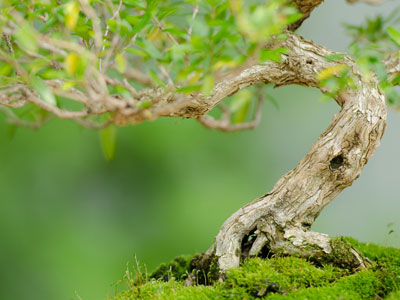Parasites and common diseases in bonsais
• Discover Bonsais
• Watering your bonsai
• Repotting your bonsai
• Pruning your bonsai
• Feeding your bonsai
• Bonsais and climatic' conditions
• Parasites and common diseases in bonsais
Bonsaï Compost
As all plants, bonsais can be prone to diseases. A regular watch and maintaining good growing conditions will help you nevertheless to limit the risks. Also, to limit any external contamination, avoid placing your bonsai under a tree or directly onto the ground, remove the dead leaves and the weeds from the pot, clean your tools before and after usage, seal the large wounds and observe your bonsai regularly with a magnifying glass.

Aphids
You will find these small insects in heaps on the young growths. They can be green, grey or orange. You will also notice the presence of ants around the bonsai, as they “raise” aphids to gather their honeydew. To kill aphids, use an organic insecticide made from Pyrethrin.
Acarids or red spiders
We have an inkling of their presence thanks to the small filaments which they produce on the back of the leaves. Acarids develop in a hot, dry environment; therefore favour a humid environment. In case of an infestation, wet the foliage regularly insisting on the back. In case of a strong attack, cut and burn the sections which are infected and shower the foliage during at least one month.
Mealy bugs
We recognise the mealy bugs by the way they form a shield fixed onto the leaves. They are white, brown, grey or even sometimes covered by a fibrous cocoon. They can be easily removed by hand or with a brush, or use an anti-mealy bugs' treatment.
Caterpillars
Caterpillar's attacks can be spectacular. However, a regular watch is sufficient to prevent attacks.
Ants
Ants do not present a real danger, but they usually go hand with hand with aphids and mealy bugs. If you see some around the pot, keep an eye on your bonsai.
White flies
They are also called “greenhouses' white flies”. They are usually found on the back of the leaves and fly away at the slightest touch. They are exclusively found on indoors' plants or greenhouses' plants. Treat your bonsai with an insecticide made from Bifenthrin to kill the adults, then one made from Buprofezin to eliminate the larva.
A whitish down on foliage
It is downy mildew. This fungus develops particularly with heat and humidity, notably at night. Avoid wetting the foliage towards the end of the day, and in case of presence of this fungus, remove the leaves which are the most affected and treat with a Bordeaux mix. This treatment has to be repeated a fortnight later.
Black stains on the leaves
These stains look like soot. This is the 'Fumagine'. This fungus develops on the honeydew produced by aphids and mealy bugs. Once you have removed the parasites, remove the honeydew with water and a soft cloth
The leaves dry get darker and fall as if they were lacking of water
You must act quickly as it is most certainly 'Phytophtora'. This fungus develops on roots in cases of excess humidity. As a preventative measure, use a well-drained substrate, respect the watering frequencies and repot your bonsai regularly so as to avoid the subsidence of the substrate. When the plant is affected, remove the parts which are affected and treat with the fungicide 'Aliette'. Unfortunately, this disease is often lethal.
In case of doubts...
If you have doubts about the procedure to follow to treat your bonsai, do not hesitate to enquire with experienced 'bonsaika' via forums, shows, in societies close to your home... A photo of the problem will always be more effective than a long speech. Think about your growing practices as may be, there is a detail at which you have never paid attention to and which could be the cause of these troubles...














































































































































































































































